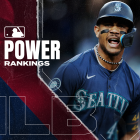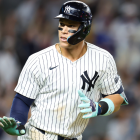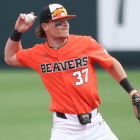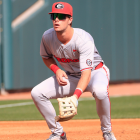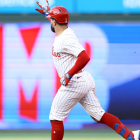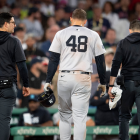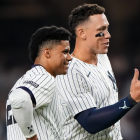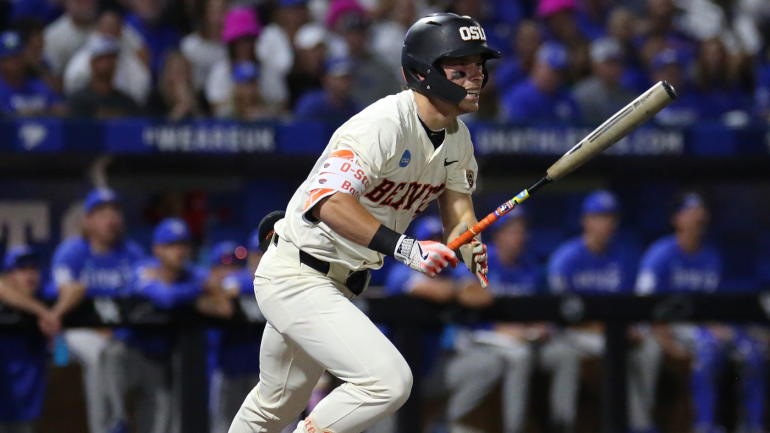
Major League Baseball's amateur draft is now exactly a month away. The Cleveland Guardians will be put on the clock come Sunday, July 14, at which point they'll make the No. 1 pick for the first time in franchise history. (The Guardians have chosen second on five occasions, most recently in 1992, when they plucked right-hander Paul Shuey from the University of North Carolina.)
MLB scouting departments across the land have spent the past couple of weeks deliberating on prospects and filling out their big boards. Today, CBS Sports will nod at those endeavors by releasing our final pre-draft rankings of the top 30 prospects in this class. As always, these rankings are formed through a multi-pronged approach that includes conversations with scouts, analysts, and directors; statistical and historical analysis; and personal opinion and biases -- hey, everyone has their share of the latter, we're just willing to admit ours.
These rankings are based on a combination of talent and expected selection range. A player ranked No. 5 overall may not actually go No. 5 overall, but should be viewed as a candidate in that general vicinity. We've noted the exceptions as part of the capsules.
With all that fine print out of the way, let's get to the good stuff.
1. Charlie Condon, 3B/OF, Georgia
The quick hook: The most talented and improved player in the class.
Condon came into the season perceived as a second-tier collegiate who needed a big spring to cement his spot in the top 10. He more than delivered. He led the NCAA in batting average, slugging percentage, and home runs (his 37 established a new BBCOR Era record). Oh, and he did all that while picking up third base and instilling the belief that that's where he should begin his career.
🤟#GoDawgs | @CharlieCondon14 pic.twitter.com/sg21pqPZji
— Georgia Baseball (@BaseballUGA) June 11, 2024
The selling point here is still the bat. Condon, listed at 6-foot-6, possesses big-time strength and the ability to reliably hammer the ball. Additionally, he seldom whiffed; he chased outside the zone less often than some of his powerful peers, like Braden Montgomery and Jac Caglianone; and his batted-ball profile aligned with the current lift-and-pull trend -- that is to say, you can call him Sephiroth with how frequently he takes aim at a cloud. Factor in how Condon survived two years of SEC vetting, and we're comfortable declaring him to be the best player in the class -- even if he doesn't necessarily end up going No. 1 overall.
2. Travis Bazzana, 2B, Oregon State
The quick hook: The rumored favorite at No. 1 can really hit.
Coming into the spring, other front offices believed the Guardians were enamored with Bazzana to an extent that's seldom heard at that phase of the draft cycle. Assuming there was truth to that perception, Bazzana provided the Guardians no reason to alter their stance. He had a phenomenal year, batting .416/.475/.937 with 28 home runs and 16 stolen bases and 40 more walks than strikeouts. Bazzana has above-average strength and speed (though a substandard arm limits him to second base), an excellent command of the strike zone, and as good of a feel for barreling balls as any player in this class. His makeup gets fawned over at every turn, even if he's often docked for being maxed-out physically. (One has to wonder what's more important for a player's long-term success: physical projection, or the metaphysical capacities for growth?) In recent weeks, the industry is again buzzing that Bazzana is the favorite to go No. 1. Of course, the Tao Te Ching states: "Those who know do not talk, and talkers do not know." These decisions do often come down to the final hours, when bluffs go out the window and it's time to do business. Should Bazzana be the pick, he would become the first second baseman to go No. 1.
3. Chase Burns, RHP, Wake Forest
The quick hook: The best pitcher in the class.
Back in February, we posed this question: "Can Burns, plus Wake Forest's genius pitching development crew (led by biomechanist Dr. Kristen Nicholson), equal this year's Paul Skenes?" Sure enough, Burns broadly followed the Skenes arc, transferring to another program ahead of his draft year and better harnessing a power arsenal that should ensure an early selection. Burns averaged nearly two strikeouts per inning thanks to a high-grade arsenal that features a rising upper-90s fastball, a swing-and-miss bullet slider, and a curveball. (He also has a seldom-used changeup.) His delivery might make you think of Matt Garza, but these deuces aren't so wild: He reliably walked fewer than 8% of the batters he faced in college, including less than 6% of those he faced this year in ACC play. Burns has all the makings of a well-above-average starter, and it shouldn't come as a surprise if he becomes the first pitcher in this class to make their big-league debut.
4. Nick Kurtz, 1B, Wake Forest
The quick hook: There's no such thing as a safe first-base prospect.
Kurtz recovered from an early slump and shoulder injury in a big way, delivering 14 home runs over a 10-game period to usher in April. By season's end, he found himself leading the NCAA in walks, both in rate and counting forms, taking a free pass in 30% of his trips to the plate. (For reference, Barry Bonds had a 32% walk rate in 2002.) There's no denying Kurtz's well-above-average power or his discipline, and to his credit he makes a solid rate of contact when he offers. There are, nonetheless, a few factors working against him. Some evaluators have questioned if his extreme selectiveness is a detriment that causes him to pass up hittable pitches; we're inclined to think it's easier to teach a hitter to ratchet up their aggressiveness than vice versa. The bigger issue, in our opinion, is that he's a collegiate first baseman. You have to go back to C.J. Cron in 2011 to find a first-round one of those who has since had a decent career. We're putting him here despite our bearish feelings on the profile because we suspect a team -- perhaps even the Athletics, who pick No.4 -- will overlook disappointments like Spencer Torkelson, Andrew Vaughn, and Pavin Smith to take the plunge.
5. Jac Caglianone, 1B/LHP, Florida
The quick hook: Incredible strength and bat-to-ball skills could be undercut by approach.
Caglianone is the most fascinating player in the class, a freak show talent denied a better ranking by transferability concerns. He features big-time power from the left side, resulting in 62 home runs and multiple 120-plus mph exit velocities over the last two seasons. He swings at everything, but his feel for contact is such that he kept his strikeout rate to an Arraezian 8%. Zone management is also an issue on the mound, where a bloated 15.7% walk rate obscured his ability to touch into the upper-90s. Because he profiles as just a reliever in pro ball, it's hard to see him remaining a two-way player all the way to the majors. In turn, that puts more pressure on his strength and bat-to-ball skills porting to the game's highest levels. There's a real chance that his approach deficiencies cause this whole thing to fall apart. But if he can make any kind of improvements on that front, he has the kind of unteachable skills that could allow him to develop into something along the lines of Yordan Alvarez with a walk allergy or a souped-up Anthony Santander.
CAGS supplies the LEAD! 💣#GoGators // 📺 ESPN pic.twitter.com/ZQTbGJrPfo
— Florida Gators Baseball (@GatorsBB) June 8, 2024
6. J.J. Wetherholt, SS/2B, West Virginia
The quick hook: Well-rounded player whose platform year was halved by injury.
Wetherholt ranked No. 1 on our preseason list thanks to a polished offensive skill set, and on talent alone he deserves to be higher than this. Unfortunately, he was sidelined for nearly two months after injuring his hamstring during Opening Weekend. That absence limited him to about a half-season's worth of at-bats; worse yet, it provided other top prospects the opportunity to leapfrog him, if only because of the perception they had greater momentum. Wetherholt should still come off the board in the top 10 and perhaps much earlier than that, in the process becoming the highest selected Mountaineer in program history. He combines an excellent feel for the barrel with an impressive command over the strike zone, convincing some evaluators to slap 70-grade projections on his hit tool. The one offensive area where he lacks is slugging capacity; it's possible his in-game power peaks at average. Plenty of other second basemen -- and that's still held as his likely defensive landing spot -- have made careers from similar profiles, including Nico Hoerner and Andrés Giménez. Wetherholt should be able to do the same.
7. Hagen Smith, LHP, Arkansas
The quick hook: Strikeout artist lefty with stuff, deception.
Smith made national headlines in February when he struck out 17 batters across six innings versus Bazzana and the Oregon State Beavers. He remained potent the rest of the way, averaging nearly two punchouts per nine innings thanks to a high-quality fastball-slider pairing and deception borne from his release point (not only does he employ a low arm slot, he also stands on the far first-base side of the rubber to create tougher angle). While there's some belief Smith could be the first pitcher selected (perhaps going as high as No. 3), he ranks behind Burns here for two reasons: 1) he doesn't have a third pitch as good as Burns' curveball, and 2) he's been wilder throughout his collegiate career, even walking 10% of the batters he faced this season. What can we say other than this: lefties often get a little extra credit in the wide world of baseball.
8. Bryce Rainer, SS, Harvard Westlake HS (CA)
The quick hook: Fits the tall, power-hitting lefty shortstop archetype.
Rainer overhauled his left-handed swing over the offseason, a move that fueled his big spring and subsequent jump into contention for the title of best prep player in the class. He's a former two-way prospect with a big arm and the necessary physical characteristics required to stick at shortstop for the long haul (though some scouts worry he will outgrow the position). The upshot here is that he slots into the same family of tall, power-hitting shortstop as Gunnar Henderson, Corey Seager, and maybe even Colson Montgomery. If there is a catch it's that he'll celebrate his 19th birthday a week before the draft. Teams have shown a willingness to overlook that blemish in players they like enough -- look no further than Bobby Witt Jr. and Jordan Lawlar, two other recent over-age shortstops who nonetheless were plucked early in the draft.
9. Konnor Griffin, CF/SS, Jackson Prep HS (MI)
The quick hook: Star-caliber tools, but sketchy hit-tool projection.
Griffin, who reclassified from the 2025 draft, entered the spring ranked as our No. 1 prep prospect thanks to his 30-30 upside. (He's still in the running for that title, but we've given the nod to Rainer.) Griffin is tall and explosive, and he ought to grow into an above-average defender at whichever position his employer plops him down at (evaluators we've spoken to think center field). The biggest thing holding him back is the uncertainty surrounding his hit tool. All the power in the world isn't worth a song or a dance if you can't make steady contact. Griffin swings and misses a lot for a top prep prospect, in part because of his tendency to nearly bar his lead arm on his swing. Whichever team drafts him (quite possibly in the top five) will have to work with him on firming up that part of his game. If they succeed, he could end up becoming a star-caliber performer.
10. James Tibbs III, OF, Florida State
The quick hook: Improved performer should go higher than expected.
Remember, our rankings are based in part on overall talent level and in part on expected pick range. Tibbs, a quality college performer who would rank about a handful of slots lower if it was only about the former, is an obvious candidate to go in or around the top 10 on a money-saving deal. He deserves a lot of credit for improving in consecutive seasons at Florida State. Tibbs went from striking out in almost a third of his plate appearances as a freshman to nearly recording as many home runs (25) as punch outs (30) as a junior. He's become physically stronger along the way, too, giving him the kind of solid offensive foundation that should make him the highest drafted FSU player since 2008, when the Giants selected catcher Buster Posey with the No. 5 pick.
All tied up courtesy of Mr. Tibbs!!
— FSU Baseball (@FSUBaseball) June 8, 2024
B3 | FSU 2, UConn 2 pic.twitter.com/2bw1XoGH9T
11. Braden Montgomery, OF, Texas A&M
The quick hook: Injured ankle muddies water for middle-of-the-order switch-hitter.
Montgomery injured his ankle on an awkward slide during a Super Regionals game against Oregon that may impact his stock. Where, exactly, he goes on draft night will be determined more by doctors than scouts. We're putting him at No. 11 to hedge our bets. A healthy Montgomery is a prolific switch-hitter who boasts well-above-average raw strength, particularly from the left side. Defensively, he'll fit in nicely in either corner thanks to a very strong arm, a remnant from his days as a two-way player. (He pitched just twice this season and shouldn't be viewed as a legitimate pro prospect on the mound.) Montgomery did strike out in nearly a quarter of his plate appearances during conference play, raising some concern about his hit tool. Provided he can keep his swing-and-miss tendencies in check as a pro, he has cleanup hitter upside.
12. Trey Yesavage, RHP, East Carolina
The quick hook: Verticality based mid-rotation starter.
Yesavage had an eventful stretch this year, returning from a collapsed lung to duel Chase Burns and the Demon Deacons in a regionals elimination game. Yesavage is a physical right-hander who pitches off a high front side and achieves a steep release point. Predictably, his arsenal is all about verticality. His low-to-mid-90s fastball features a lot of rise, and he complements it with a series of secondary pitches, including a hammer curve and a bat-missing split-change. Yesavage's mid-rotation upside should allow him to become the third Pirates pitcher ever selected in the first round, joining fellow righties Jeff Hoffman (No. 9 in 2014) and Gavin Williams (No. 23, 2021).
13. Seaver King, CF/INF, Wake Forest
The quick hook: Fast middle-of-the-diamond player with approach concerns.
King transferred from Wingate to Wake ahead of last season, but the improved quality of competition didn't faze him. Instead, he was one of the most productive hitters on a loaded Wake team, and he even posted a higher OPS during conference play than he did outside of it. King has an appreciable feel for contact that, though accompanied by a chase-happy approach, enabled him to keep his strikeout rate to 12%. Defensively, he recorded 10 or more appearances at shortstop, center field, and third base. The hot corner was his primary position, but it's possible his future employer would prefer him in center field, where he can leverage his plus speed into a no-fly zone. He should be the third Demon Deacon taken in the top half of the first round.
14. Jurrangelo Cijntje, RHP/LHP, Mississippi State
The quick hook: Even true switch-pitchers have a favored hand.
Cijntje (that's "SAIN-ja") is a switch-pitcher, and not in a gimmicky sense: he's capable of clearing 90 mph with both arms. He's also not a switch-pitcher in a committed sense, as he primarily throws with his right arm these days. That's a wise decision since he shows better velocity (into the upper 90s) and stuff (top-notch fastball and good breaking ball) from that direction. Cijntje is on the shorter side (listed at 5-foot-11) but he's a good athlete who averaged nearly six innings per pop this season. We think some team will pluck him earlier than anticipated with dreams of him becoming a right-handed middle-of-the-rotation starter.
Jurrangelo Cijntje with the ⛽
— Mississippi State Baseball (@HailStateBB) March 17, 2024
📺» https://t.co/u0pJT8tsTs#HailState🐶 pic.twitter.com/vMXQrDxHYL
15. Cam Caminiti, LHP, Saguaro HS (AZ)
The quick hook: Lefty with velocity, bloodlines.
Ken Caminiti's cousin is an athletic southpaw who throws hard and has shown some propensity for improving. He made tweaks to his arsenal over the offseason, including his breaking balls, but some evaluators have wondered if he'll be best served picking up a gyro slider once he turns professional -- that way he might develop a true out pitch to pair with his heater. There are a lot of risks associated with taking a prep pitcher in the first round, yet the latest buzz has Caminiti coming off the board at some point over the first 15 picks to a team envisioning him as a mid-rotation starter.
16. Ryan Waldschmidt, OF, Kentucky
The quick hook: A bat on the rise.
Waldschmidt has been a favorite of analysts since earlier in the spring, and he's now positioned to become the third Kentucky hitter in the last 30 years to go in the first round, joining Evan White and Chad Green. Waldschmidt, who barely strides before launching his swing, combines good strength with a tight command of the strike zone and good enough athleticism to swipe 24 bases on the year. He also performed better inside than outside of conference play, earning that pivotal SEC stamp of approval.
17. Theo Gillen, SS, Westlake HS (TX)
The quick hook: Pure hitter with wheels.
Gillen seems likely to be the third high-school batter off the board, behind Rainer and Griffin. Some scouts consider him to be one of the best pure hitters in the class, an attribute owed to his mature approach and propensity for hitting line drives. There's likely to be some juice here, too, as he continues to fill out his 6-foot-2 frame. The big question facing Gillen is where he plays positionally; he's a well-above-average runner, yet he has a below-average arm after undergoing shoulder surgery to repair a torn labrum. It's possible Gillen ends up at either second base or perhaps in the outfield, where his set of wheels would allow him to cover a generous patch of land. Provided he hits the way some evaluators think he might, it won't end up mattering too much.
18. Carson Benge, OF/RHP, Oklahoma State
The quick hook: Two-way player with promising bat.
Benge threw more than 60 innings for the Cowboys over the last two seasons and would go in the top five rounds if he were a full-time pitcher. Yet he's a superior prospect as a hitter, to the extent that his professional career will come as an outfielder. Benge has shown an appreciable feel for making contact and posting good exit velocities. He nearly walked more than he struck out for a second consecutive season, and he established a new career-high in home runs along the way. Benge's offensive skill set, and the possibility that he takes a step forward by focusing only on hitting (thereby allowing him to get the ball in the air more often than he did in college), should land him somewhere in the middle portion of the first round.
.@Carsonbenge3 doing @Carsonbenge3 things#GoPokes pic.twitter.com/xoHlJor9Sc
— OSU Cowboy Baseball (@OSUBaseball) April 7, 2024
19. William Schmidt, RHP, Catholic HS (LA)
The short hook: Live-armed prep righty.
Schmidt, an LSU commit, is a projectable right-hander with a lot of points working in his favor. He possesses both good velocity and a high-spin curveball, giving him an electric foundation from which to build. Scouts have expressed concerns dating back to the spring about his tendency to get onto the side of the ball when he throws his heater, causing the offering to play down because of suboptimal movement. His arm action also sees his elbow get awfully close to the shoulder line; that tends to be a negative indicator for future command. Schmidt's upside is such that he should go sometime in the first round, even if he's unlikely to be the first prep arm selected.
20. Cam Smith, 3B, Florida State
The quick hook: Slugger with a big arm.
We noted in the preseason that Smith had finished the Cape Cod League in such strong fashion that some evaluators had wondered if he was taking the same road Tommy Troy and Matt Shaw did to the first round. Smith subsequently blazed the Troy-Shaw Parkway, improving his triple-slash statistics by more than 100 points on average and slicing his strikeout rate from 28.7% to just over 15% with a swing change. The sticking point now is that it's not a given Smith will stick at the hot corner for the long haul. He does have a strong arm, however, and it's clear that he's willing to put in the work to get better; at the same time, we're hedging in case he has to move across the diamond or into the outfield, where the pressure would be on his power and patience porting in whole.
21. Christian Moore, 2B, Tennessee
The quick hook: Proven SEC bat with positional questions.
Moore was the most productive hitter on a 50-win Volunteers team that also featured fellow potential first-round pick Billy Amick. He launched 29 home runs, including three in a late-season contest against Kentucky (two of which went out to the opposite field). Moore keeps his barrel tight to his body throughout his swing, and he initiates from a setup that might remind you of former World Series MVP Édgar Rentería. Rest assured, the similarities end there. Whereas Rentería's game was built around contact and defense, Moore's is all about mashing and then mashing some more. He's not a highly skilled defensive player, and it's possible he transitions to the corner outfield before reaching the majors. Teams will live suboptimal defensive outcomes, along with a slew of other things, if the bat delivers; Moore's seems like it has a solid chance to do just that.
22. Kaelen Culpepper, SS, Kansas State
The short hook: Shortstop with offensive question marks.
Culpepper is the only collegiate on this list we feel confident will regularly play shortstop at the major leagues. He took over at the six this season, having previously played third out of deference to 2023 Blue Jays draftee Nick Goodwin, and showed off the requisite arm strength and athleticism to play it at an above-average level heading forward. Some serious offensive questions prevented us from ranking Culpepper higher. While he has a good feel for contact, he's a little too swing-happy (in part because of some sketchy breaking ball pitch recognition) and he boasts limited muscle. (He posted a sub-.050 ISO in last summer's Cape Cod League.) For whatever it's worth, Culpepper has some late momentum, having hit for the cycle and homered off Hagen Smith during regionals.
Signed. Sealed. Delivered.#KStateBSB x @thechosen1kc pic.twitter.com/BK5IFRtWSE
— K-State Baseball (@KStateBSB) June 7, 2024
23. Vance Honeycutt, CF, North Carolina
The short hook: Elite secondary skills, but what about the bat?
Honeycutt combines high-grade outfield defense with the kind of power-speed combination that allowed him to record two 20-20 seasons in three tries at UNC. Unfortunately, his game possesses a potentially fatal flaw in his substandard hit tool. Honeycutt whiffs a lot, resulting in a 28% strikeout rate that ticked higher during conference play. There are big-league center fielders who can make an elevated K rate work -- Brandon Marsh, Byron Buxton, and Jose Siri among them -- but punching out that often in The Show isn't as alarming as doing it in college. (Even Drew Stubbs, one of the forefathers of this profile, never struck out as much as 25% of the time at Texas.) Honeycutt's secondary value gives him plenty of offensive wiggle room, but there's a chance he outgrows that space if he can't get his swing-and-miss tendencies under control.
24. Caleb Lomavita, C, California
The short hook: Legit defensive catcher with approach issues.
Lomavita entered the spring ranked as our No. 1 backstop in the class. We're keeping him there, in part because he's a legitimate defensive backstop (and in part because it's a lackluster group), but we do have some concerns about his offensive game. He homered 31 times over the last two seasons and showed a good ability to hit for average. The hiccup here is that he possesses a serious walk allergy. Lomavita drew a free pass in fewer than 5% of his trips to the plate, all the while striking out nearly four times as often as he walked during conference play. The hope here is that Lomavita's defense and feel for the barrel can atone for what figures to be an empty on-base percentage.
25. Malcolm Moore, C, Stanford
The short hook: Offensive upside overshadows defensive questions.
Moore is a difficult prospect to nail down. In theory, he's a catcher who homered 16 times and walked more than he struck out in a power conference while showing an appreciable feel for contact. Moore hit only .255, however, because of his tendency to hit a lot of fly balls -- his ground-ball percentage finished under 29%. Batting average isn't the end-all be-all at any level, but first-round bats generally fare better in their platform years. Add in how Moore may have to move off catcher, and he'll probably be selected by a team who truly believes in his lumber.
26. Kellon Lindsey, SS, Hardee HS (FL)
The short hook: Speedster with variable offense.
Lindsey, a Florida commit, is a former two-sport star and one of the top athletes in the class. He possesses top-of-the-scale speed and more than enough arm for the left side of the infield. The reason he's here and not higher is because there are concerns about how his bat will take against higher-level pitching -- especially in the early going, and especially given how most first-round prep players have performed in A-ball since the minor-league reorganization. By the same token, the reason he's here and not lower is because he's an enticing upside play in a top-heavy draft.
27. Brody Brecht, RHP, Iowa
The short hook: Massive arm, massive volatility.
Brecht is the toughest pitcher in the class to rank. Some evaluators have said they don't consider him to be a first-round candidate because of usability concerns; others have floated him as a potential top-10 pick. To paraphrase Søren Kierkegaard: draft him or don't draft him -- you'll regret it either way. What makes Brecht so polarizing? He has a tantalizing arsenal, including a fastball that regularly runs into the 100s and two swing-and-miss secondaries, a slider (his best pitch) and a splitter. He struck out more than 37% of the batters he faced this season and -- more importantly -- he made serious gains with his walk rate. Two things can be true at once: Brecht issuing free passes to 11% of batters during conference play was a huge step in the right direction for him while also still representing the kind of below-average control that would make him one of the wildest starters in MLB.
BB-8̶14 #Hawkeyes pic.twitter.com/xByKJPleWg
— Iowa Baseball (@UIBaseball) May 4, 2024
28. Dakota Jordan, OF, Mississippi State
The short hook: All-Star upside if the usability catches up.
Jordan is the biggest boom-or-bust hitter in the class. He has remarkable physicality, including elite strength and well-above-average speed. If everything clicks, he might be the steal of the draft. Alas, the odds are very much against that scenario. Jordan's subpar bat-to-ball skills resulted in a 31% strikeout rate against SEC foes, and he remains a work in progress on the basepaths and in the outfield. It's hard to find many recent SEC batters who punched out that frequently in conference play ahead of successful careers. The best we could do was Edouard Julien -- and he was an 18th-round selection for a reason. This kind of strikeout-heavy profile usually slips out of the first round, including in the recent cases of Jud Fabian and Christian Franklin, but it takes only one team to conclude that Jordan's upside is impossible to pass on in the mid to late stages of the first round.
29. Carter Johnson, SS, Oxford HS (AL)
The short hook: Solid lefty-hitting infielder.
As we noted in the spring, Johnson was already eliciting comparisons to Gunnar Henderson, Walker Martin, Colt Emerson, and other contemporary lefty-hitting infielders. (It's a happening profile these days.) While those players are all shortstops, scouts are unsure if Johnson will remain at the six, or if he'll need to slide over to second or third base. Regardless, there's a chance that he develops into an above-average hitter at maturation, and that should ensure he goes high enough (in the first round or otherwise) to forgo his commitment to Alabama.
30. Braylon Doughty, RHP, Chaparral HS (CA)
The short hook: Polished prep arm with late helium.
Doughty isn't your typical first-round prep arm. He's a short right-hander with an outstanding commitment to Oklahoma State whose game is based on polish, not projection. Scouts expect him to become a No. 4 starter thanks to good control and feel for a quality curveball. The usual caveats about taking a prep right-hander in the first round still apply. History suggests it shouldn't surprise anyone if Doughty ends up finding his way into the top 30 or so picks anyway.














